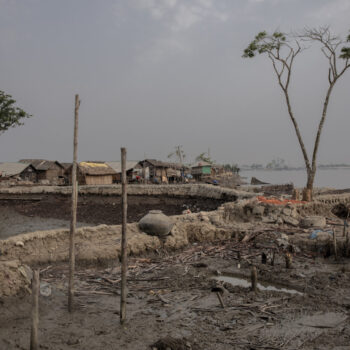In 2014 the conundrum of climate finance must be resolved. Without this, hopes for reaching agreement on a new legally binding treaty at the Paris climate summit, December 2015, will diminish. Without a compelling offer on finance, the polarisation between developed and developing countries will be reinforced.
There are several dimensions to this climate finance conundrum, all of which will need to be progressed during the course of 2014. All dimensions will require diplomatic efforts to reach convergence around a middle ground that is both realistic and ambitious. Some of the dimensions will need to be informed by technical work at the international as well as national levels.
Broadly in 2014 there is the need for agreement on the amount of finance developed countries are prepared to put on the table for immediately assisting developing countries with their climate actions. There is also need for progress towards a long-term finance pathway from 2020.
The specific elements that must be progressed during 2014 are:
Triggering pledges to the Green Climate Fund
Agreement by the Board of the Green Climate Fund on six essential issues required to trigger a pledging process at Ban Ki-Moon’s Climate Summit. As this Summit in September 2014 will be the first time that Heads of Government come together to discuss climate change since Copenhagen in 2009, it is inconceivable that they remain silent on the commitment they then made for jointly mobilising $100bn/year by 2020 for supporting developing countries’ climate actions. All eyes are therefore keenly focused on the GCF Board meeting in May as key to unlocking pledging in 2014. Whilst the stakes are high, all are agreed that the GCF will evolve over time. So there is no need to have every detail on each of the six essential issues ironed out in May.
Clarity on a long-term finance pathway to 2020 and beyond
Pledges made by Heads this September will need to focus on capitalising the GCF in order that money can start flowing to developing countries as soon as 2015. Clarity on a long-term finance pathway must also progress this year. Key to achieving this will be securing greater transparency and predictability regarding the climate finance to be provided, and reaching a balance between finance for mitigation with that for adaptation.
Transparency and Predictability
At a basic level, transparency and predictability of finance are required for tracking the climate finance provided and are important in building trust between the providers and recipients of climate finance. At a more practical level, transparency and predictability of climate finance are also important for public and private sector decision-makers aiming to access climate finance for greatest catalytic impact. They are in everyone’s interests. Whilst final decisions will inevitably be political in nature, they will need to be underpinned by technical work on the parameters, criteria and reporting systems for international climate finance. The Standing Committee (SC) on finance is preparing the first biennial assessment and overview on climate finance flows to be presented to the Lima conference in December. Ministers gathering in Lima must be unequivocal on the importance of taking up the recommendations of the SC and sending a bold signal for the SC’s agenda for 2015.
Sustainable Development Finance Regulation
The Intergovernmental Committee of Experts on Sustainable Development Financing will also be reporting to Ban Ki Moon this September, and should provide recommendations for the design of the global financial system capable of transforming our economies towards sustainable development. Several other initiatives in this area are bubbling up to place focus on the real economy issues that are required to shift the trillions of dollars of investment away from high carbon assets towards those characterising low carbon and resilient economies. Much of the innovation in this area is occurring in emerging economies, as demonstrated by the Sustainable Finance Regulators Network which meets this year in Nigeria.
Rebalancing a supply-side to country-driven focus
Rebalancing the traditional bias of these various UN-related and GCF processes from a supply-side focus towards design of the international ecosystem for climate finance that is shaped by what works at the country level is also important. Many developing countries are in the process of developing their national ecosystems for climate finance. The GCF focus on ‘readiness’ for accessing climate finance, and the funding already available to support countries with readiness activities, is a welcome boost. Ensuring country experiences and realities influence the processes shaping the international ecosystem whilst it remains fluid is essential to avoid repeating the previous shortcomings of climate finance initiatives.
Accelerating learning and knowledge
Another priority for 2014 must therefore be to enhance the way in which evidence and lessons are communicated as to what countries require for financing the implementation of low emission and resilient paradigms of development. The SC Forum held in June will focus on assimilating lessons learnt from adaptation finance; it is immediately followed by the Climate Investment Funds Partnership Forum. Together these Fora can draw from the extensive body of experience that has been developed over the past 5 years to communicate more widely the experience of climate finance in delivering transformational impact. It is important to also understand what further barriers and constraints may need to be confronted.
The Low Emissions Development Strategies Global Partnership meeting, also held in June, will continue bringing practitioners together for peer-to-peer learning on national strategies for financing low emission and climate resilient development plans. Another interesting initiative is the Partnership for Climate Finance and Development. Having emerged from the Busan process, the Partnership recognises the primacy of country budget systems, planning and reporting processes for the effective use of climate finance. In placing emphasis on country ownership of climate finance, creating balance with the prevailing supply-side focus, it can also be valuable in generating knowledge of how climate finance can deliver transformational impact.
Four elements to crack during 2014
In sum, 2014 must deliver in four major areas of climate finance. First is capitalisation of the GCF, via pledges made in September by Heads of Government. Second, Lima must adopt the parameters, criteria and reporting systems that will characterise a long-term finance pathway beyond 2020. Third is the need to redress the supply side focus, for example by expanding support to countries with national financing strategies and pathways as important ways of increasing their readiness for deploying climate finance for transformational impact. And fourth, in 2014 efforts to capturing emerging lessons in a way that positively impacts on the international ecosystem for climate finance must be intensified.
Some of the Twitter reaction to this article:
Read @EthreeG's commentary on which elements should be progressed in 2014 to solve the conundrum on #climatefinance http://t.co/SxiDuFI6Ku
— UNFCCC (@UN_ClimateTalks) April 23, 2014
All you need to know about the state of #climate finance discussions… by @EthreeG guru Amal Lee-Amin http://t.co/Mc7c3SFybb
— Edward King (@rtcc_edking) April 16, 2014


